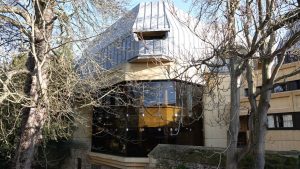Common Worship Almanac for 2021-22
My Almanac for the liturgical year 2021–22, the year beginning Advent Sunday 2021 is now available. The Almanac is a complete and customizable download that can be added to the calendar on a desktop/laptop, a tablet or a smartphone providing a fully-worked out calendar and lectionary according to the rules of the Church of England. Several download formats are provided, giving access to most calendar software on most devices.
As before, download is free, and donations are invited.
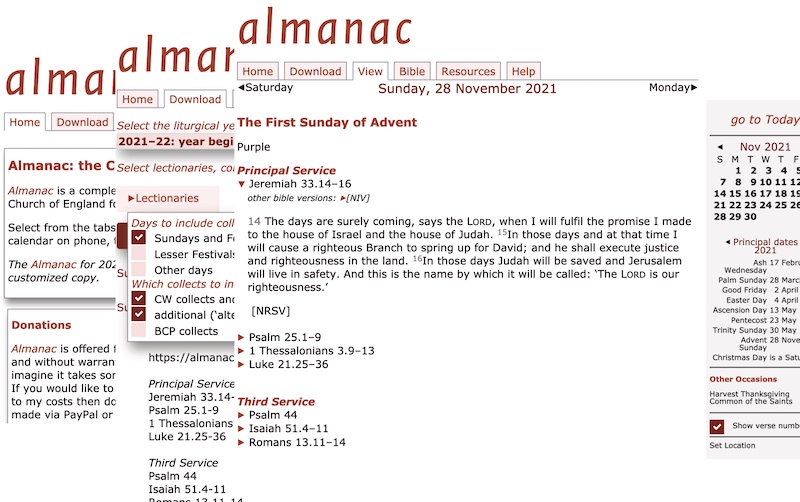
What's new?
The Almanac is also available as a web page that can be installed as a web app on smartphones and tablets for easy access to all the data. New features include
- the Download tab now shows a live preview of the data that will be added to your calendar; as you select options from the menus the live preview automatically reflects your choices
- in the View tab you can toggle the display of verse numbers in the readings, making it simpler to copy and paste passages to other documents in the desired format
- in the View tab the bible readings now have an additional link to the NIV text at Bible Gateway, as well as displaying the NRSV text (or the Common Worship psalter for psalms)
- a new shorter format for subscription links (old-style links continue to work as well)
Donations
This Almanac is offered free of charge, and without warranty, but as you might imagine it takes some effort to compile. If you would like to make a contribution to my costs then donations may be made via PayPal at paypal.me/simonkershaw. Alternatively, Amazon gift vouchers can be purchased online at Amazon (amazon.co.uk) for delivery by email to simon@kershaw.org.uk .
The Almanac has been freely available for over 20 years. There is not and has never been any charge for downloading and using the Almanac — this is just an opportunity to make a donation, if you so wish. Many thanks to those of you who have donated in the past or will do so this year, particularly those who regularly make a donation: your generosity is appreciated and makes the Almanac possible.
0 CommentsAn act of iconoclasm
There’s lots of talk at the moment of toppling statues and removing items commemorating historical figures with what is now seen as a dubious past. Here is a little story that has never been told before.
In June 1980, 41 years ago, I was an undergraduate at Wadham College, right at the end of my three years at Oxford. I lived in a room in a small courtyard on top of the then-new college library. The library, opened three years earlier, had been significantly funded by a donation from the Iranian imperial family, and was named after the twin sister of the Shah, Princess Ashraf Pahlavi, and there was a plaque commemorating this dedication over the inside of the main entrance. The funding and the dedication had been fiercely criticised by the student body and others, and a number of protests took place while I was at the college. In February 1979 the Shah had been overthrown and had gone into exile, as had his sister, but the library dedication remained, and so did the plaque.
Although not to everyone’s architectural taste, I liked the new library building (by Glasgow architect Andy MacMillan of Gillespie, Kidd and Coia), and knew every public corner of it. There were also parts that were out of bounds to undergraduates, and eventually I discovered that at the dead of night when there was no one else around then you could venture unchallenged through any “no entry” signs or unlocked doors. In particular, there was a spiral staircase leading from the downstairs reading lounge up to the limited-access Persian section. The Persian section had another access door from the floor on which it was, but my recollection is that that door was normally locked.
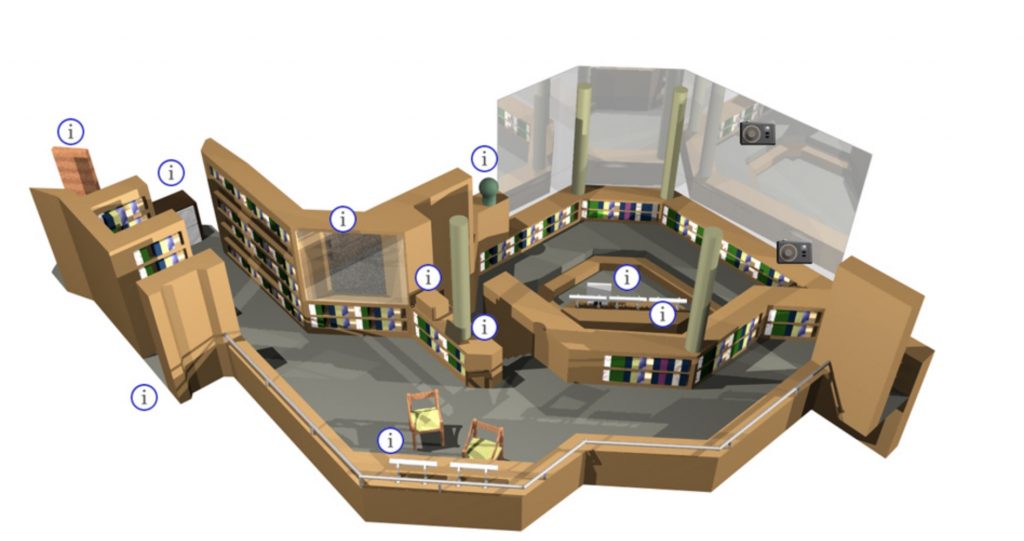
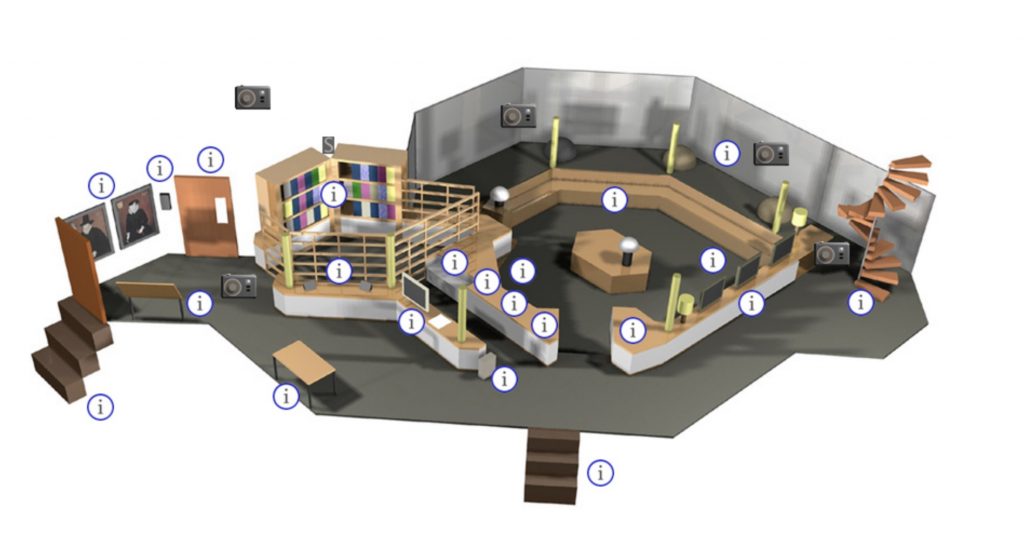
It was during one of these night-time explorations that I discovered (as you do) that the Pahlavi plaque over the main door was very simply fixed to the library wall, with just a couple of keyhole slots on the back that fitted over some screws in the library wall.
And so an idea formed in my mind, as I was nearing finals that June. Wouldn’t it be fun, I thought, to remove the plaque? But how to dispose of it? The idea sat in my head for a few weeks as I revised and sat my finals. Many subjects held their finals early in the summer term, but for my subject, physics, finals were right at the end of term, and afterwards nearly all undergraduates left Oxford. I had already arranged to stay in college for a few more days.
One night after the end of term, when all was quiet, I went downstairs from my room into the library. I walked all round to be sure that there was no one else in the library, and I checked the place where I had thought of putting the plaque. All was deserted. Back at the entrance I reached up and gently lifted the plaque from off the wall over the door. It was about 3 feet or so long, 10 inches high and perhaps an inch or two deep, solid oak and moderately heavy. Across the library and up the spiral staircase, and I was into the closed Persian section. The bookcases here were tall, over 6 feet, and I carefully placed the plaque on top of one, where it could not be seen from below, and where it was not possible to look down from above. Or, and here my memory is a little hazy after all these years, did I come out of the Persian section and into the upper level of the library and place it on top of a bookcase there? Either way, it would not be found accidentally.
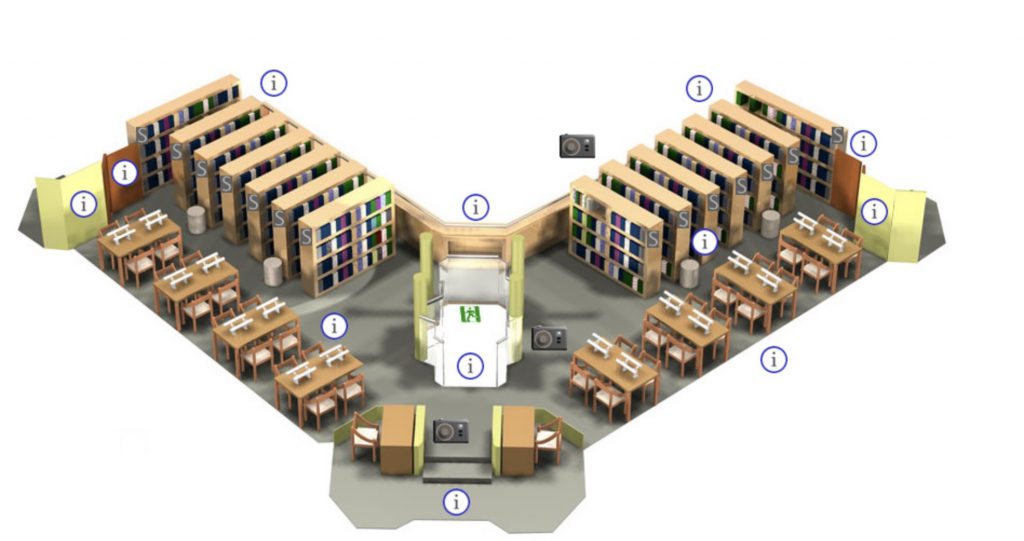
Was it a protest at the Iranian regime, or a student prank? A little bit of both I suppose. I had thought of putting a sign in its place with words such as “the Ayatollah Khomeini Library” – that would certainly have made it a prank in my eyes, but I didn’t carry through with that.
It was a couple of months later, in mid-September, during the long summer vac, and before I started my first job, that I returned to Oxford for a few days. Wandering round the college I bumped into the chaplain (Peter Allan, later a monk at Mirfield) and we arranged to have lunch the next day, at the Trout at Wolvercote, if I recall correctly, or was it the Perch at Binsey? “Did you hear,” he asked me, “that someone had removed the Pahlavi plaque from the library, and it had disappeared?” “And what,” I said as innocently as I could, “is the college doing about it?” “They’re just relieved that they don’t have to decide what to do with it,” he replied. So much, I thought, for my little act of rebellion. But I stayed silent. And I have stayed silent until today.
I’ve never heard whether the plaque was found, though some time later I left a note in the library saying where I had put it. Several years later the library was renamed the Ferdowsi Library after the Persian poet Abul-Qâsem Ferdowsi Tusi (c.940‑1020), a much less divisive figure.
This diagrammatic view of the library shows how the different levels interact (and the default view shows the entrance door, over which the plaque was sited, and the spiral staircase up to the Persian section)
https://weblearn.ox.ac.uk/…/virtualtour/mezzanine.html
These pictures show the exterior and inside of the library, and apart from the presence of computers, it was pretty much the same in 1980.
https://www.wadham.ox.ac.uk/…/a‑day-in-the-life-of…
Two further links
https://en.wikipedia.org/wiki/Andy_MacMillan
https://en.wikipedia.org/wiki/Ashraf_Pahlavi
